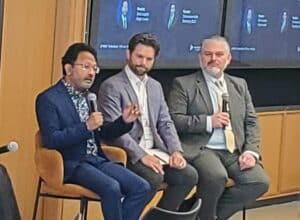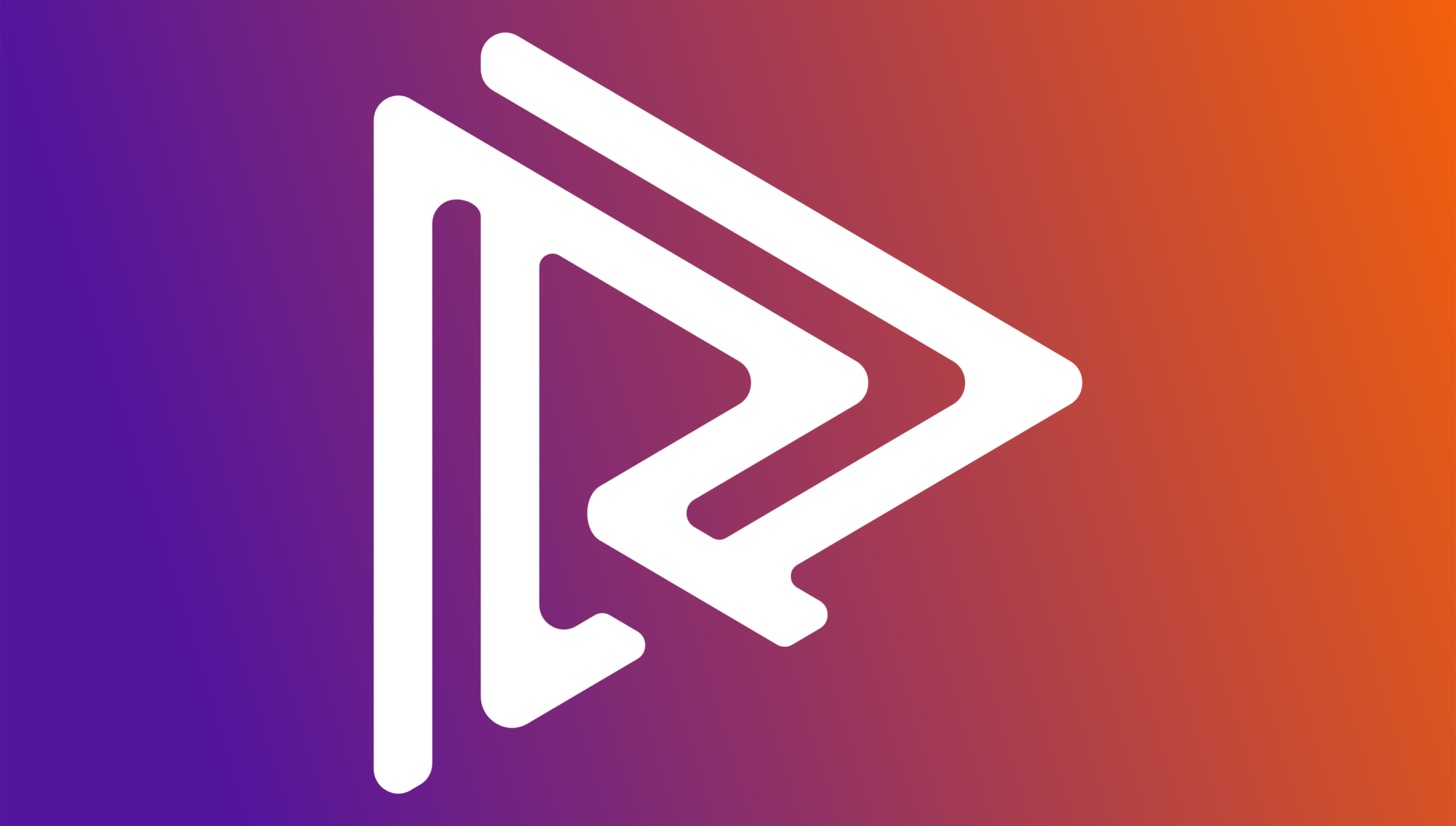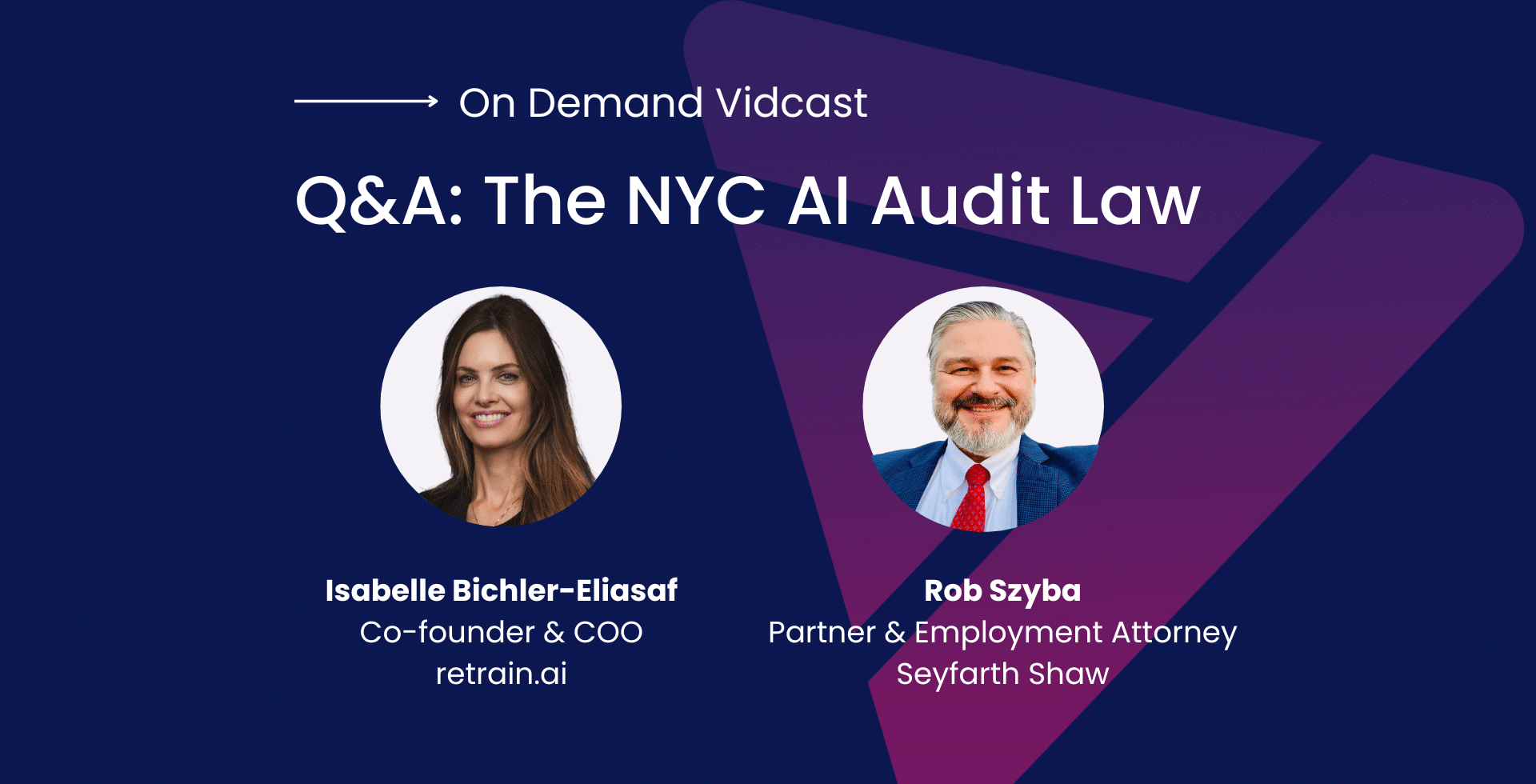There’s something incredible that happens when thought leaders and knowledge seekers gather to explore a critical topic. Such was the vibe at the first-ever Responsible HR Forum presented by retrain.ai. Below, find a brief overview of the day’s sessions, which you can now access as podcast or vidcast recordings.
Keynote: EEOC Commissioner Keith Sonderling
 Starting off the day, keynote speaker Commissioner Keith Sonderling of the EEOC shared insights on the expansion of Responsible AI governance across the U.S., emphasizing that current regulations put the onus on businesses using AI systems to ensure they generate fair end results–not on the makers of AI systems.
Starting off the day, keynote speaker Commissioner Keith Sonderling of the EEOC shared insights on the expansion of Responsible AI governance across the U.S., emphasizing that current regulations put the onus on businesses using AI systems to ensure they generate fair end results–not on the makers of AI systems.
Watch the vidcast | Listen to the podcast
Ready or Not, Regulations Are Coming
 Talk of Responsible AI continued into the first panel discussion, where Commissioner Sonderling was joined by Scott Loughlin of Hogan Lovells, Rob Szyba of Seyfarth Shaw and Niloy Ray of Littler to discuss the new AI Audit Law in New York City, the far-reaching implications of seemingly local regulations, and how the European Union’s approach to AI governance differs from the U.S.
Talk of Responsible AI continued into the first panel discussion, where Commissioner Sonderling was joined by Scott Loughlin of Hogan Lovells, Rob Szyba of Seyfarth Shaw and Niloy Ray of Littler to discuss the new AI Audit Law in New York City, the far-reaching implications of seemingly local regulations, and how the European Union’s approach to AI governance differs from the U.S.
Watch the vidcast | Listen to the podcast
The Paradox of the HR Mission: Creating a Multidimensional View of Talent
 In conversation with retrain.ai’s Amy DeCicco, Dr. Anna Tavis of the Human Capital Management Department at New York University and Dr. Yustina Saleh from The Burning Glass Institute posed provocative questions, encouraging attendees to think about questions like whether empathy is truly a skill or a trait, or how HR leaders can tell from a skills profile whether or not a candidate will be able to do the job needed.
In conversation with retrain.ai’s Amy DeCicco, Dr. Anna Tavis of the Human Capital Management Department at New York University and Dr. Yustina Saleh from The Burning Glass Institute posed provocative questions, encouraging attendees to think about questions like whether empathy is truly a skill or a trait, or how HR leaders can tell from a skills profile whether or not a candidate will be able to do the job needed.
Watch the vidcast | Listen to the podcast
Becoming a Skills-Based Organization: More Than a Trend?
 With more enterprises talking about transforming to an SBO model, Dr. Sandra Loughlin of EPAM Systems shared lessons learned from her company’s transformation, while Heidi Ramirez-Perloff discussed The Estee Lauder Company’s exploration into SBO strategy. Urmi Majithia of Atlassian delved into executing technology to help overcome the challenges of becoming an SBO, and Ben Eubanks of Lighthouse Research & Advisory broke down the larger SBO concept to a tangible level regarding individual employees and hiring managers.
With more enterprises talking about transforming to an SBO model, Dr. Sandra Loughlin of EPAM Systems shared lessons learned from her company’s transformation, while Heidi Ramirez-Perloff discussed The Estee Lauder Company’s exploration into SBO strategy. Urmi Majithia of Atlassian delved into executing technology to help overcome the challenges of becoming an SBO, and Ben Eubanks of Lighthouse Research & Advisory broke down the larger SBO concept to a tangible level regarding individual employees and hiring managers.
Watch the vidcast | Listen to the podcast
The Hidden Architecture of a Skills-Based Organization
 Following the panel discussion, Dr. Loughlin sat down for a one-on-one with retrain.ai CEO Dr. Shay David to go more in depth into EPAM’s experience developing a thriving SBO strategy, sharing benefits, pitfalls and lessons learned along the way.
Following the panel discussion, Dr. Loughlin sat down for a one-on-one with retrain.ai CEO Dr. Shay David to go more in depth into EPAM’s experience developing a thriving SBO strategy, sharing benefits, pitfalls and lessons learned along the way.
Watch the vidcast | Listen to the podcast
Can Innovation and Regulation Co-Exist? How ChatGPT Sparked the Conversation
 No discussion around Responsible HR would be complete without an exploration of the huge impact ChatGPT and other generative AI solutions are having on the tech space. Leading a fascinating discussion on the topic were Yuying Chen-Wynn of Wittingly Ventures and Art Kleiner of Kleiner Powell International, who examined the potential of generative AI to greatly improve business systems, as well as the ethical AI use questions that remain in the midst of growing regulation.
No discussion around Responsible HR would be complete without an exploration of the huge impact ChatGPT and other generative AI solutions are having on the tech space. Leading a fascinating discussion on the topic were Yuying Chen-Wynn of Wittingly Ventures and Art Kleiner of Kleiner Powell International, who examined the potential of generative AI to greatly improve business systems, as well as the ethical AI use questions that remain in the midst of growing regulation.
Watch the vidcast | Listen to the podcast
Continuing the Conversation: The Responsible HR Council
To conclude the Responsible HR Forum, retrain.ai announced the formation of our Responsible HR Council. Like the Forum, our Council will involve experts from academia, law, enterprise, government and nonprofit sectors. We’ll meet quarterly to get up to speed on new AI legislation, new AI technologies, and the melding of the two within Responsible HR practices. Check back for details soon!
retrain.ai is a Talent Intelligence Platform designed to help enterprises hire, retain, and develop their workforce, intelligently. Leveraging Responsible AI and the industry’s largest skills taxonomy, enterprises unlock talent insights and optimize their workforce effectively to lower attrition, and win the war for talent and the great resignation. retrain.ai fuels Talent Acquisition, Talent Management and Skills Architecture, all in one, data-driven solution. To see it in action, request a demo.











